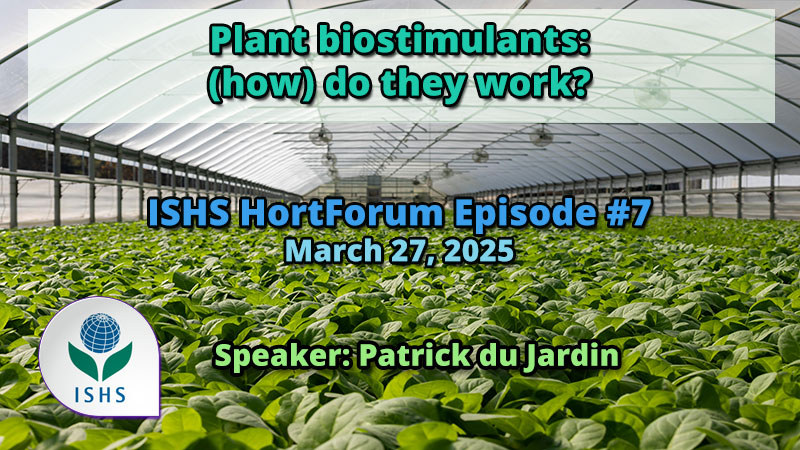
ISHS Hort Forum Episode 7: Plant biostimulants: (how) do they work?
Thursday, March 27, 2025, Hours: 17:00 – 19:00 Central European Time (CET)
Registration for this episode is open. Use the registration link below to register. Participating is free of charge but registration is required.
For more information and to view previous episodes check https://www.ishs.org/hortforum
Speaker: Prof. Patrick du Jardin, Plant Biology laboratory, Gembloux Agro-Bio Tech, University of Liege (Belgium)
- Organizers: Ted DeJong, UC Davis (USA), George Manganaris, Cyprus University of Technology (Cyprus)
- Panelists: Vassilis Fotopoulos, Cyprus University of Technology (Cyprus), Patrick Brown, UC Davis (USA), Petronia Carillo, University of Campania Luigi Vanvitelli (Italy), Fabricio Cassan, Universidad Nacional de Rio Cuarto (Argentina), and Antonio Ferrante, Sant’ Anna School of Advanced Studies (Italy)
Thursday, March 27, 2025, Hours: 17:00 – 19:00 Central European Time (CET)
Registration link: https://us02web.zoom.us/webinar/register/WN_BEdz861nTvKHd80a4xISiw
Plant biostimulants have been recognized as a new regulatory category of fertilizing products in different parts of the world, but their properties and uses still need to be clarified. A main reason is that their definition is based on claims of agricultural effects – which are increased nutrients use efficiency, improved tolerance to abiotic stress, enhanced product qualities and increased availability of soil nutrients, according to the new European regulation (EU) 2019/1009 – but how these claims are substantiated in practice is still unclear, fueling skepticism among growers. The EU approach consists in defining harmonized standards, bearing on agreed definitions, quality criteria and protocols for generating data on the efficacy of the products. Compliance of the data package provided by the companies to the adopted standards will be regarded as sufficient for validating the claims, as indicated by the ‘CE-marking’ of the products. In USA, a self-certification program promoted by the biostimulants industry aims at basing farmer confidence on validated protocols for efficacy testing as well.
Whatever the regulatory efforts and industry initiatives, confidence in the products will depend on the knowledge of the mechanisms of biostimulation, allowing a sound advice in products uses. Although many scientific articles on biostimulants have been published in peer-reviewed journals over the last twenty years, several bottlenecks can be identified in the understanding of biostimulation. For instance, many articles use single substances (which can be multicomponent), whilst most marketed products combine several biostimulant substances, sometimes added to micro-nutrients, making it difficult to assign the observed effects to individual constituents or to specific interactions between constituents. Also, biostimulants aim at interacting with life processes of plants, which respond to many environmental factors and also depend on the genetic makeup of the variety. Furthermore, any plant is now regarded as a “superorganism”, or holobiont, associating plants and microorganisms, and many biostimulants will act via these complex associations.
I also argue that adoption of biostimulants not only depends on products efficacy but on how the grower will understand their potential added value in the context of the many challenges faced by agriculture. In this respect, biostimulants seem to offer a unique opportunity to bridge plant nutrition and plant health, emphasizing the need to extend ‘plant care’ to the strengthening of the plants’ capacity to withstand adverse environments and to cope with the scarcity of nutrients and water resources, which are all challenges amplified by climate change.
Hort Forum Episode 7: Abstract, speaker, organizers and panelists brochure: download here




